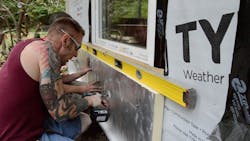How to Install Exterior Rigid Foam, Part 1
Remodeler David Joyce, owner of Synergy Construction, in Lancaster, Mass., and his crew performed a deep energy retrofit and gut rehab last fall on a home in Concord. To boost the R-value of the envelope, they added 4 inches of polyisocyanurate foam in two 2-inch layers to the walls and roof. This article focuses on the first layer on the walls.
The existing T1-11 siding was structurally sound so it was left in place and covered with housewrap and foam. The windows are new and were installed and flashed to the openings before the housewrap was applied, then the housewrap was sealed to the windows with flashing tape.
The two layers of foam should have offset seams, so the crew started with a ripped strip of foam that fit under the windows and ran the full length of the house. This first course was kept level to ensure consistent measurements.
At windows, the foam overlaps the window frame, forming a tight seal. The crew measures and cuts carefully to create a 2 1/4-inch reveal around the window. They also pull the pan flashing out past the foam so that any leaks can drain all the way out.
Cutting the foam sheets is pretty simple. The crew uses utility knives with extendable segmented blades to cut full depth on short cuts and when cutting sheets in place. For long cuts, they sometimes use a knife and a chalk line or T-square, but a table saw works best for long cuts, especially beveled cuts where wall and roof foam edges meet.
The first layer of foam is held in place with long screws and washers. For large pieces and full sheets, one screw is adequate to hold the foam in place; add a second if needed to keep it from rotating. Small pieces can be friction fit because the entire first layer will be held in place by the furring strips that will be applied on top of the second layer of foam.
There’s no need to tape the seams on the first layer either because when the furring strips are installed later, the foam will compress and pull the tape away from the seams. The second layer will be taped, and any loose tape caused by compression from the furring strips can be re-adhered or replaced.
As one guy installs, he can also measure for the next piece. Working together, two installers ought to be able to keep ahead of one cut man.
This article was adapted from a video produced by Dan Morrison for ProTradeCraft.com. Thanks to Synergy Construction's David Joyce, Patrick Burke, Calvin Cutts, and Damien Higgins for sharing their jobsite with us. For Part 2 in this series, watch the video “How to Install Polyiso Panels” at ProTradeCraft.com.
About the Author
Daniel Morrison
Editorial Director
Daniel Morrison is the editorial director of ProTradeCraft, Professional Remodeler, and Construction Pro Academy.

